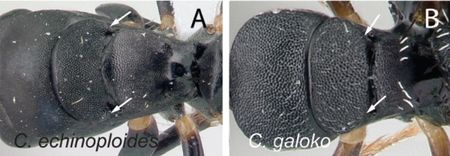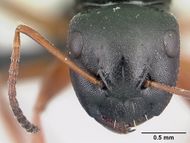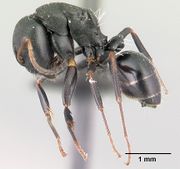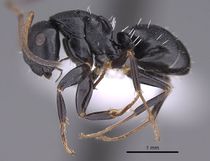Key to Malagasy Camponotus edmondi species group
This species group has been revised (Rasoamanana and Fisher 2022), and a few changes to the species included (Camponotus edmondi species group). A new key includes all of the species that are currently part of the C. edmondi species group.
Key to Malagasy Camponotus subgenus Mayria minor workers
This worker key is based on: Rakotonirina J.C., Csosz S., and B.L. Fisher. 2016. Revision of the Malagasy Camponotus edmondi species group (Hymenoptera, Formicidae, Formicinae): integrating qualitative morphology and multivariate morphometric analysis. ZooKeys. 572:81-154. doi:10.3897/zookeys.572.7177
The key applies to both minor and major workers.
You may also be interested in:
1
- In profile, anterior margin of petiolar node convex and posterior margin more or less straight; propodeal spiracle located on lateral portion of propodeum, anterior to posterolateral margin of propodeum (Fig. 5A) . . . . . 2
- In profile, anterior margin of petiolar node convex and posterior margin either convex or roughly triangular; propodeal spiracle located on declivitous surface or at posterolateral margin of the propodeum (Fig. 5B) . . . . . 6
2
return to couplet #1
- Larger species (CS: 1.882–3.725; CL: 1.961–3.686; ML: 3.098–4.667); body color uniformly black to dark brown (Fig. 6A) . . . . . 3
- Smaller species (CS: 0.875–2.222; CL: 0.98–2.275; ML: 1.373–2.902); body bicolored, head and mesosoma black to dark brown, gaster and appendages lighter in color (dark brown to depigmented yellow) (Fig. 6B) . . . . . 4
3
return to couplet #2
- Level of the propodeal dorsum abruptly lower than level of the promesonotal dorsum; pronotal dorsum with few erect hairs; humeral angle extended anteriorly into a narrow ridge (Fig. 7A) . . . . . Camponotus ethicus
- Level of propodeal dorsum not abruptly lower than level of promesonotal dorsum; pronotum covered with numerous erect hairs and pubescence; humeral angle slightly tuberculate, not extended into a narrow ridge (Fig. 7B) . . . . . Camponotus robustus
4
return to couplet #2
- In profile, anterior margin of pronotum broadly rounding to the dorsum; dorsolateral and posterolateral margins of propodeum strongly carinate (Fig. 8A); somewhat larger species (CS: 0.991–2.222; CL: 1.078–2.275; ML: 1.62–2.902) . . . . . Camponotus alamaina
- In profile, anterior margin of pronotum very short and indistinct, the cervical shield apparently joins the pronotal dorsum directly; at least posterolateral margin of propodeum not strongly carinate, but simply marginate or rounded (Fig. 8B); generally smaller species (CS: 0.875–1.739; CL: 0.98–1.922; ML: 1.373–2.235) . . . . . 5
5
return to couplet #4
- In dorsal view, dorsolateral portion of propodeum with sharp carina, posterolateral margin marginate (Fig. 9A); in profile, width of mesopleuron, seen at the level of spiracle, about as large as that of lateral portion of propodeum; at least one pair of erect hairs present on propodeal dorsum . . . . . Camponotus androy
- In dorsal view, dorsal face of propodeum rounded to lateral face, junction without sharp carina, and posterolateral margin rounded (Fig. 9B); in profile mesopleuron, taken at spiracle level, much wider than lateral portion of propodeum; erect hairs lacking on propodeal dorsum . . . . . Camponotus bevohitra
6
return to couplet #1
- In profile, propodeum strongly compressed anteroposteriorly, without clear distinction between dorsal margin and declivity (Fig. 10A); in dorsal view, mesonotum broad, at least twice as broad as long (Fig. 10B) . . . . . 7
- In profile, propodeum not strongly compressed anteroposteriorly, propodeal dorsum and declivitous surface separated by blunt angle (Fig. 10C); in dorsal view, mesonotum narrow, less than twice as broad as long (Fig. 10D) . . . . . 8
7
return to couplet #6
- Posterodorsal corner of mesonotum raised into a bluntly rounded shield (Fig. 11A); somewhat larger species (CS: 1.235–2.667, 1.6; CL: 1.255–2.647, 1.625; ML: 1.843–2.922, 2.257) . . . . . Camponotus echinoploides
- Posterodorsal corner of mesonotum rounded, not forming an extended shield (Fig. 11B); somewhat smaller species (CS: 1–1.722, 1.265; CL: 0.961–1.725, 1.29; ML: 1.341–2.078, 1.623) . . . . . Camponotus galoko
8
return to couplet #6
- In profile, straight line connecting one end of dorsolateral carina of propodeum at the metanotal groove to the other end next to propodeal spiracle conspicuously longer than posterolateral margin of propodeum (Fig. 12A) . . . . . Camponotus matsilo
- In profile, straight line connecting one end of dorsolateral carina of propodeum at the metanotal groove to the other end next to the propodeal spiracle approximately as long as posterolateral margin of propodeum (Fig. 12B) . . . . . 9
9
return to couplet #8
- Dorsum of head and mesosoma densely and finely reticulate punctate (Fig. 13A) . . . . . 10
- Dorsum of head and mesosoma smooth and shiny, superimposed by fine imbrication (Fig. 13B) . . . . . 13
10
return to couplet #9
- Dorsum of mesosoma with numerous erect hairs, pubescence conspicuous (Fig. 14A) . . . . . Camponotus mifaka
- Hairs lacking on dorsum of pronotum; a pair of hairs present on mesonotum; dorsum of propodeum covered with few erect hairs; hairs on propodeum mostly arise along the region separating dorsal surface and declivity; pubescence inconspicuous (Fig. 14B) . . . . . 11
11
return to couplet #10
- Distance between meso-metapleural suture and dorsolateral margin of propodeum remains the same along the dorsolateral carina of propodeum (Fig. 15A); no distinct angle between dorsal margin of propodeum and declivity, both portions apparently forming a straight line . . . . . Camponotus orombe
- Distance between meso-metapleural suture and dorsolateral margin of propodeum variable, largest near the junction of dorsolateral carina and declivitous surface (Fig. 15B); blunt angle or convexity between dorsal margin of propodeum and declivity distinct . . . . . 12
12
return to couplet #11
- With mesosoma in dorsal view, lateral margins of mesonotum roughly straight and gradually converging posteriorly; width of propodeum at the metanotal groove less than half the maximum width of mesonotum (Fig. 16A); with head in full-face view, anteromedian margin of clypeus truncate . . . . . Camponotus edmondi
- With mesosoma in dorsal view, lateral margins of mesonotum convex and strongly converging posteriorly; width of propodeum at metanotal groove greater than half the maximum width of mesonotum (Fig. 16B); with head in full-face view, anteromedian margin of clypeus triangular . . . . . Camponotus tafo
13
return to couplet #9
- In profile, mesonotal dorsum strongly sloping down to the level of propodeum, maximum length of mesonotum about as long as distance between metanotal groove and propodeal spiracle (Fig. 17A); in dorsal view, lateral margin of mesonotum not well defined and converging gradually towards metanotal groove (Fig. 17B); head and mesosoma brown . . . . . Camponotus tratra
- In profile, mesonotum slightly sloping down to the level of propodeum, maximum length distinctly shorter than distance between metanotal groove and propodeal spiracle (Fig. 17C); in dorsal view, lateral margin of mesonotum well defined and evenly convex, converging abruptly towards metanotal groove (Fig. 17D); head and mesosoma dark brown to black . . . . . 14
14
return to couplet #13
- In profile, anterodorsal corner of pronotum extending anteriorly into narrow edge but dorsolateral portion not marginate, junction of dorsum to lateral surface always rounded; blunt angle between dorsal margin of propodeum and declivity distinct, or the junction between both portion rounded (Fig. 18A); antennal scape and gastral tergites I-III covered with abundant ap-pressed pubescence (Fig. 18B) . . . . . Camponotus zavo
- In profile, anterodorsal corner of pronotum extending anteriorly into narrow edge and dorsolateral portion marginate; junction of dorsum to lateral surface of pronotum sharply angulate; no distinct angle between dorsal margin of propodeum and declivity, both portions apparently forming a straight line (Fig. 18C); antennal scape and gastral tergites I-III with scattered appressed pubescence (Fig. 18D) . . . . . Camponotus varatra











































